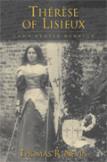Great Saint of the Little Way
At a recent viewing of the film “Into Great Silence,” I was mesmerized as the camera circled the austere perimeter of a new Carthusian novice’s cell and oratory, stripped of any comforts or signs of individuality. And then, there she was: pasted to the wall near a bare cross, a small, celebrated photo of a young Carmelite nun, the only human face this man would see during long hours of solitary contemplation at La Grande Trappe. Removed in time by more than a century, St. Thérèse of Lisieux still influences and fascinates millions, reaching a world unimagined by the French bourgeois Catholicism from which she emerged. Her relics have circled the globe, including Iraq, Siberia and Cameroon. She is venerated as “daughter of Allah” in Islamic circles, with her own shrine in Cairo. The complete body of her written work is available on the Web, and library databases list over 300 published volumes on the subject of Thérèse. Is there anything left to unearth about the Little Flower, one of the church’s most beloved saints? This new monograph illustrates how an enterprising researcher can approach this saint’s deceptive simplicity and find there a complex spiritual universe for postmodern exploration.
Thomas Nevin begins his unconventional study by firmly rejecting any hagiographical objective, with a caveat that Thérèse has had more than her share of pious biographies. A professor of classical studies at John Carroll University, Nevin has authored works about Simone Weil and others he describes as “overripe intellectual sorts.” After reading Thérèse’s autobiography, he abandoned plans for a scholarly book on 19th-century French Catholicism and chose to focus entirely on her. Combing through the extensive published collection of primary and secondary works, as well as previously untapped archival materials, Nevin has achieved an intriguing and uncompromising social history of Thérèse, of her “life and times” as daughter and sister, as Carmelite, author and tubercular patient. The unconventional titles of Thérèse of Lisieux’s nine chapters are a tip-off that Nevin will forgo the chronological approach for a richer and more challenging portrayal of Thérèse from within her historical and cultural contexts. One chapter, for example, “How They Paved the Little Way,” focuses on 19th-century Car-melite life and practice. Two are given over to Thérèse’s “theatricality” and writings, with emphasis on her poetry and plays. One focuses on tuberculosis, Thérèse’s doctors and how they treated and mistreated her disease. Introductory texts for each chapter have been judiciously chosen, and all citations are in the original French, with accompanying translation, which sometimes interrupts the flow of the narrative account.
From the outset, Nevin portrays the saint as a surprising antithesis to three well-known figures of 19th-century Catholicism. François de Chateaubriand, Félicité de Lamennais and Ernest Renan, gifted interpreters of post-revolutionary French idealism, failed in their efforts to renew Christianity, while Thérèse succeeded in shifting her co-religionists from a religion of fear to one of love with her “little way.”
Many have written about Thérèse’s sense of abandonment, beginning with the death of her mother, Zélie, when she was only four, and of her lifelong quest for the nurturing of maternal love. Of nine children to whom she gave birth, Zélie lost two sons and a daughter in infancy, and another daughter at the age of five. Thérèse was born when Zélie was 42, her health and psychic stamina already severely compromised. A constant in the Martin family dynamic was the overarching presence of suffering and death and the challenges these posed to their Catholic faith and hope. Nevin devotes a chapter to this subject by examining Zélie’s abundant correspondence, 217 extant letters that offer clues to her inner life and her evolving relationships with each of her surviving daughters. They reveal the “travails” of a wife and mother, as well as the economic ups and downs of a shrewd and hardy businesswoman. Nevin ar-gues that through Zélie the lace-maker, we come to know the Martin family more intimately and realistically than through Louis, the dreamer-father who looms large in most Theresian biographies.
With his last chapter and “inconclusions,” Nevin achieves a profoundly creative interpretation of Thérèse’s theology, centered on the compelling imagery of the “table of sinners,” a recurring theme in her “Manuscript C,” the last section of the autobiography. He disputes “the consolations of the commentators,” who try to illumine and soften what she herself describes as near-blasphemy. Portraying herself as the sister of those who have no faith, who eat the bread of sorrow, Thérèse takes her place at that table, without faith or hope, in the shadows of exile. Among the unbelievers and the derelict, she finds her bodhi tree and sits there with empty hands and a heart full of love—little, weak, a nothing. This, Nevin claims, is the source of her luminous theological originality, and qualifies her as an exemplar of where the love of God and others meets Christ crucified in the human community, and as “Christendom’s foremost voice to non-Christian worlds.”
This is a book to be pondered and discussed, by those who think they know Thérèse well, and by those at the table of darkness, doubt and grief she continues to share and bless.
This article also appeared in print, under the headline “Great Saint of the Little Way,” in the June 18, 2007, issue.








